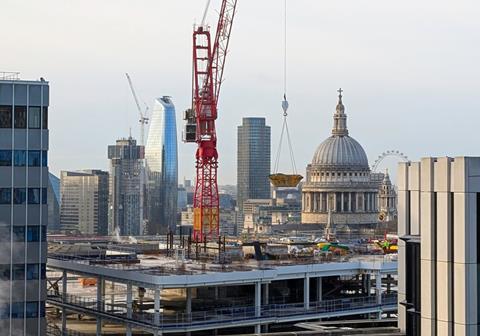Delayed starts, gateway 2 hold-ups, tax hikes and cautious clients keep PMI score in negative territory
Confidence remained firmly in negative territory for the third consecutive month with another fall in construction output, according to new PMI data.
The S&P Global UK Construction Purchasing Managers Index hit 46.4 in March, a rise from February’s near five-year low of 44.6, but still well below the 50 no-change threshold.
The bellwether index said: “Lower volumes of construction output have now been recorded for three consecutive months and the latest reading indicated a solid pace of contraction.”

Civil engineering with a score of 38.8 was the weakest performing area of activity with the decline attributed to delayed decision-making on new projects and a generally subdued pipeline of major infrastructure work.
Residential construction activity declined at a slower pace than in February but the figure pf 44.7 was still well in negative territory.
Commercial building with a score of 47.4 decreased slightly but worries remained over lacklustre UK economic prospects and the impact of rising geopolitical uncertainty on clients’ investment spending.
The index added: “Lower levels of incoming new work have been recorded throughout 2025 to date. Construction companies often noted a lack of sales enquiries and greater competition for new work.
“Lower workloads, elevated interest rates and worries about the broader economic outlook continued to weigh on business activity expectations in March. Confidence across the construction sector slipped to its lowest since October 2023.”
And it added the survey was beginning to show a fall in employment. “Latest survey data indicated a reduction in staffing numbers for the third consecutive month. The rate of job shedding was the steepest since October 2020. Subcontractor usage also decreased at a solid pace in March.”
Tim Moore, economics director at S&P Global Market Intelligence, said: “A lack of new projects, alongside pressure on margins from rising payroll costs, led to hiring freezes and the non-replacement of departing staff in March. The net result was the fastest pace of job shedding across the construction sector for nearly four-and-a-half years.”
The index also said that higher payroll costs due to forthcoming rises in National Insurance contributions and the National Minimum Wage continued to push up average cost burdens. The overall rate of input price inflation accelerated to its strongest since January 2023.
From Trump tarrifs to gateway 2 hold-ups: the industry reacts
Gareth Belsham, director of Bloom Building Consultancy
“There’s only one thing worse than this snapshot of declining industry sentiment - the fact that it was captured before Donald Trump’s ‘Liberation Day’ announcement.
“While the direct impact of US tariffs on UK construction will be modest, their chilling effect on business sentiment is real. Boards worrying about a possible recession later this year need a very good reason to sign off on a big capital investment right now.”
Victoria Whitehead, head of infrastructure and transport at Lloyds
“A rise in output is testament to the sector’s efforts to navigate the first quarter. While a challenging environment could continue to weigh on demand, firms remain cautiously optimistic and are looking ahead to potential future opportunities, particularly in the infrastructure space.”
Brian Smith, head of cost management and commercial at Aecom
“The recent Spring Statement reaffirmed the government’s commitment to infrastructure – including a £13bn capital investment package covering key areas such as housing and defence. With a more stable investment climate, this points to potentially better months ahead and we hope to see this momentum maintained through the upcoming spending review. A cut in the interest rate in May would help unlock greater confidence among clients and investors to proceed with projects that had been on hold, although we probably need to see a fall in inflation first.”
Huda As’ad, Accenture’s UK Capital Projects lead
“The industry’s ongoing struggle with pressures of supply chain disruptions and escalating material costs, combined with wider economic uncertainty, have led to increased strain across the sector and a fall in confidence. The industry will be looking to be more agile to evolving market pressures. It is crucial for the industry to focus on its operational resilience – which means it can no longer afford to lag in the technology stakes.”
Kelly Boorman, National Head of Construction at RSM UK
“The fall in civil engineering activity signals ongoing concern that there’s a major lag in project mobilisation which is causing uncertainty. Delays and cancellations of large-scale infrastructure projects creates a huge headache for the industry and without government intervention to accelerate mobilisation of major projects and commit funding for delivery, some contractors will find it hard to remain viable.”
Atul Kariya, head of construction and real estate at MHA
“With the cost of employing staff kicking in from 1 April, it is no surprise that we’re seeing stagnant growth and declining confidence in the construction sector. Given construction is a leading indicator for the wider economy this does not bode well for the UK economic outlook for 2025.
“The situation has been compounded by the challenges associated with Gateway 2 approvals that are running behind. Significant upfront costs and the system working slower than intended have delayed many projects in the sector. Even when the backlog clears, there is a concern that if it doesn’t do so at a steady rate, we could see temporary spikes in demand leading to labour shortages and wage inflation.
“Yet, there remains hope for construction businesses robust enough to withstand these fierce storms. 2025 will continue to be bumpy year for the construction sector, but the outlook for 2026 and 2027 with growing order books and increasing optimism looks promising.”




























No comments yet